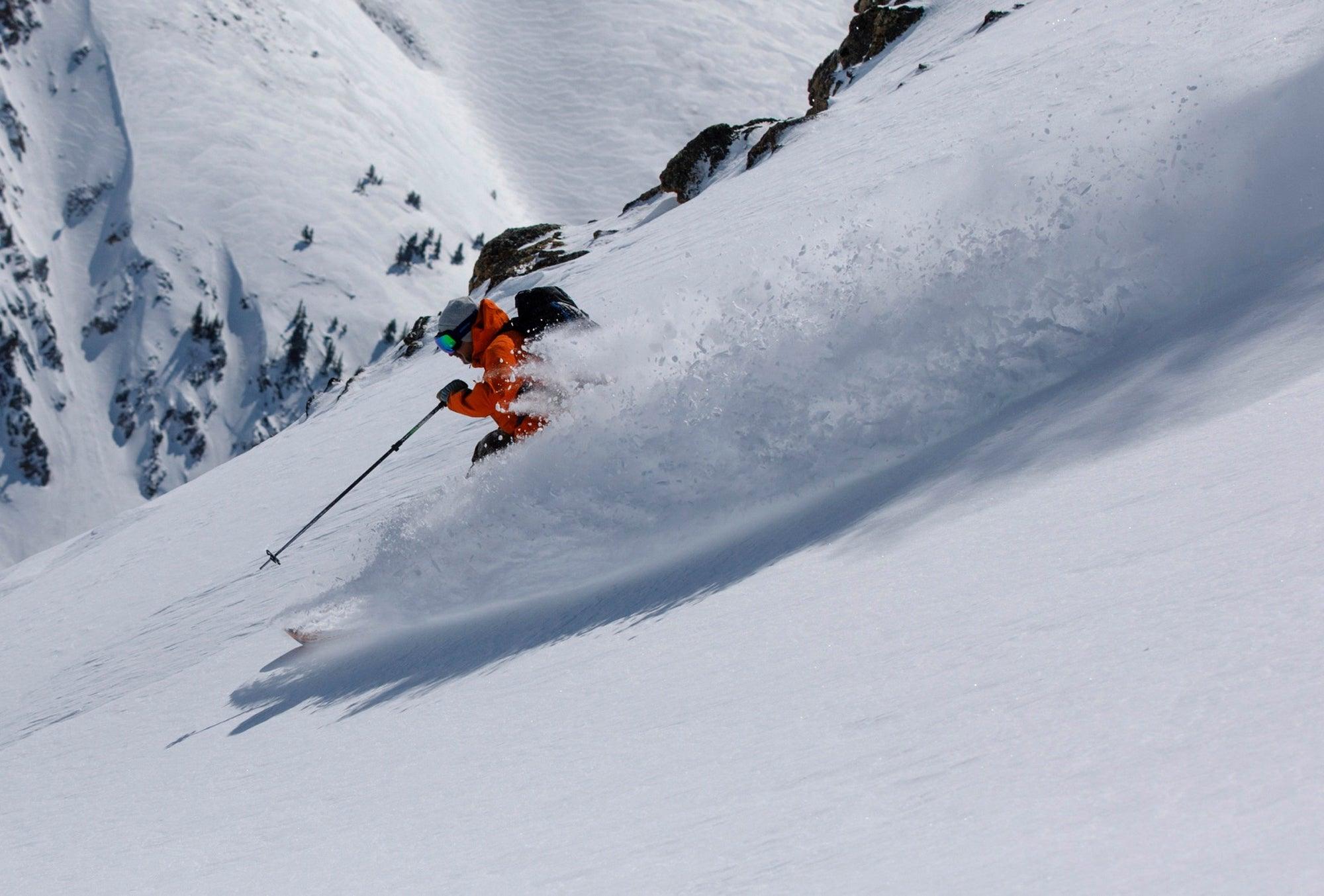The breadth of backcountry skis is staggering, with nearly every big ski brand producing its own touring skis. From carbon race skis to beefy freeride planks, there's an option out there for everyone. To make life easier for the backcountry skiing enthusiast, we've curated a list of our favorite skis in each category. If you're scratching your head and wondering about the difference between all-mountain, freeride, and ski mountaineering skis, check out our in-depth description of backcountry ski quiver slots here. As always, there's a lot to unpack here, so don't hesitate to reach out to book a gear consultation. Getting granular with ski gear makes our day!
All mountain
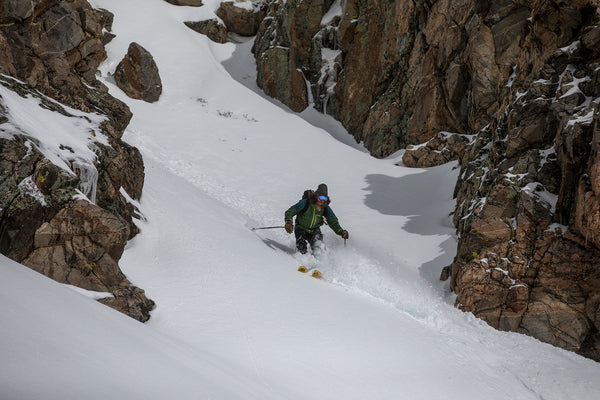
Black Crows Camox Freebird
For those familiar with the touring world, it's no surprise that the Camox Freebird makes the list. It’s consistently one of our top-selling skis and is widely considered the most versatile and well-rounded touring ski in production. 2023 saw the Camox Freebird updated with a lighter, full Paulownia wood core reinforced with carbon and fiberglass and a tapered sidewall that gives a softer tip and tail flex. Weighing in at 1475 grams (178 cm), the Camox isn't the lightest all-mountain ski, but this is more than compensated for by its stable and damp feel and consistent performance across all snow conditions.
What we like
We love the Camox Freebird because its highly versatile downhill performance endears it to various skiing styles, wants, and needs. It has the signature damp and stable performance synonymous with Black Crows’ construction. This makes the ski a favorite for newer tourers trying to avoid the chatter often associated with lighter skis on hard-packed snow. Similarly, expert skiers love the Camox because it maintains stability at high speed, and the moderate underfoot camber and tip rocker allow for a consistent turn and reliable underfoot feel through the full range of speeds and turn styles.
What we don't like
In its current iteration, the Camox was redesigned to lose some weight and make it more competitive with lighter touring skis. This was accomplished through a new core construction and a thinner ABS sidewall. While we appreciated the switch to a full Paulownia wood core, we wish the ABS sidewall hadn't been reduced, as this is such a critical part of ski durability and feel. We haven't seen a noticeable uptick in warranties, but at least personally, we value ski design that puts a premium on durability. The other thing to note with the Camox Freebird is more qualitative and subject to personal preference. Still, some with an alpine skiing background built on racing and aggressive turns find the Camox to feel lifeless and not have a good energy return. The ultimate takeaway is that if you like an aggressive ski that hooks into a turn and needs to be aggressively driven, look elsewhere.
Bottom Line: A consistent and versatile ski, the Camox Freebird provides a damp yet lightweight touring ski that’s easy to turn and suitable for a wide range of snow conditions and styles.
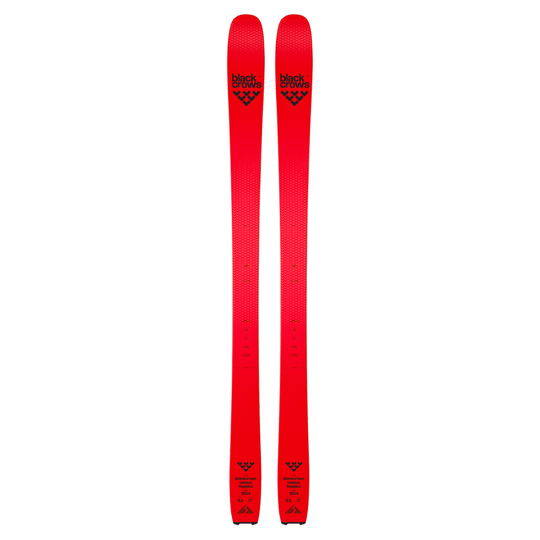
Kastle TX93
The Kaslte TX 93 has lovingly been dubbed the mascot of touring skis in the Aspen area, where Cripple Creek is based. It's the ski of choice for guides and avid ski mountaineers looking to descend some of the most iconic lines in the country. The TX93 takes advantage of decades of fine Austrian ski design and packs enormous performance into a lightweight ski (1275g, 170 cm). It’s tight sidecut and snappy turns pair with a wide shovel tip and rocker camber profile that adapt to snow conditions. In powder, you’ll be surprised by its float; on hardpack, you’ll be surprised by how well it carves and bites into the snow.
What We Like:
The TX93 has a great performance-to-weight ratio thanks to its Paulownia core and carbon fiber laminate, which keep it stable and rigid. Core construction is paired with an excellent shape. The tight sidecut and camber give this ski a snappy, tight turn ideal for steep lines and tight trees. The tip rocker and large shovel allow the TX93 to open up in softer snow and ark longer turns with plenty of flotation.
What we don’t like:
The TX93 uses premium materials and packs a correspondingly premium price tag. You get what you pay for, but sometimes, the price tag turns our customers off of a ski that would otherwise be perfect for them. The TX93 is also designed for expert skiers, and if a less experienced skier finds themselves on the TX93, they may find it unwieldy. The TX93 requires an active and driven style, and sitting back and hoping for the turn to initiate itself won't work.
Bottom line: The Kastle TX93 is the go-to ski for advanced skiers looking for versatility and performance in a lightweight ski. It’s ideal for people looking to carve beautiful turns in a wide variety of conditions
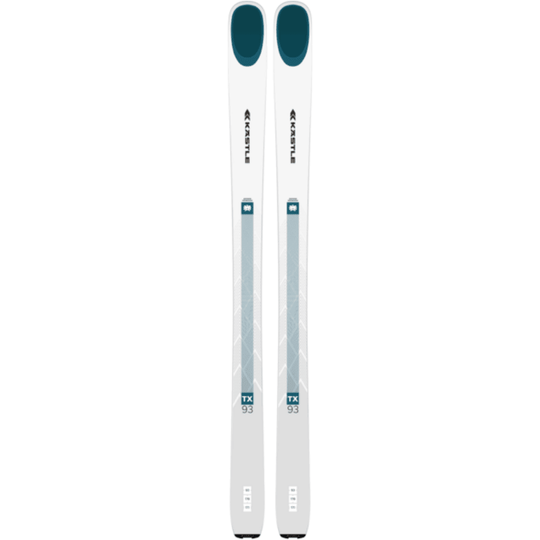
DPS Pagoda Tour 100 RP
The DPS Pagoda Tour 100 RP is about as close to a one-ski quiver as it gets. At 100 mm underfoot, with a generous shovel and tip rocker, the 100 RP provides plenty of float for all but the deepest days. It’s no understatement to say DPS has the most advanced ski construction in the world, and their fine attention to performance is reflected in the Pagoda Tour construction. We won't dive too deeply into the world of DPS ski design because it gets overly granular quickly, but if you want a deep dive, check out this review by wildsnow.com.
What we like
The 100 RP is an awesomely well-rounded ski, and if you have a quiver of touring skis, you will likely find yourself grabbing in more than any other. It's extremely easy to turn and control, and people often say it makes them feel like better skiers. DPS uses the highest quality materials, which translates to great durability and their carbon ski are now backed by a lifetime warranty.
What we don't like
A new DPS Pagoda Tour ski now comes with a $1,549 MSRP; as many of our customers have pointed out, they can buy two skis for that price. Sure, the Pagoda Tour skis like a dream and is durable and light, but you pay a premium.
Bottom line: The DPS Pagoda Tour 100 RP is a superb touring ski that will perform admirably in just about any condition you might find in the backcountry.
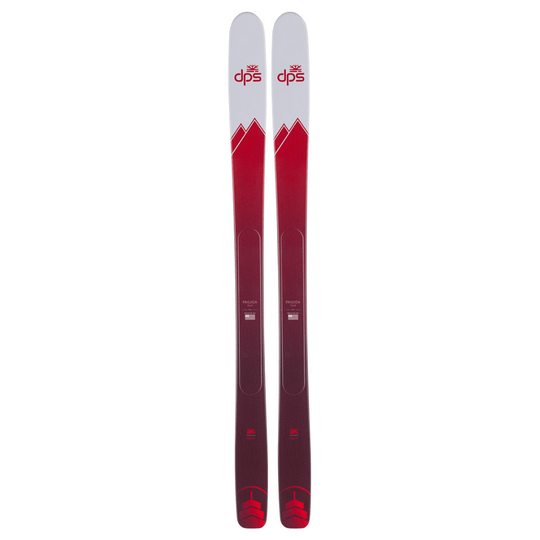
Ski Mountaineering and Speed Touring
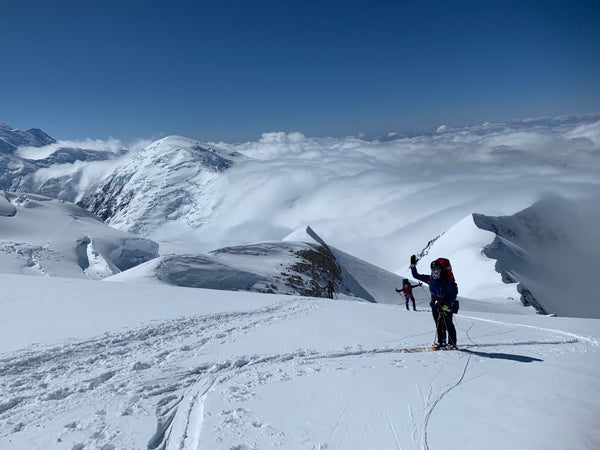
Dyanfit Blacklight Pro
The Dynafit Blacklight Pro Ski is an exceptional touring ski tailor-made for ski mountaineers, fitness tours, and weight-conscious backcountry skiers. It excels in rapid ascents and demanding alpine environments. Dyanfit uses their Pauloewnia Race Core for the Blacklight, and this skimo race pedigree shows in the 960g weight (172 cm). That Blacklight Pro is designed for going uphill fast and getting you down in one piece, and in this sense, think of it like a mountaineering tool designed to move you through challenging terrain in the most efficient way possible.
What we like
Last year, during a post-work resort lap with a coworker on Blacklights, we were caught in a whiteout without headlamps in the dark. When we made it down, my coworker expounded on his love of the skis and how he could trust them in bad conditions, how they were confidence-inspiring, and how, as he nursed them down the mountain nearly blind, they kept him upright and moving. This is why we love the blacklights; they are stiff carbon planks that dig into the snow and keep you upright and moving. We also enjoy the Dynafit skin tip attachments, which provide a well-thought-out integration and simplify transitions.
What we don’t like
With the Blacklight Pro using the Dynafit Race construction, a premium has clearly been put on saving weight. This results in all the normal problems you would expect with an ultralight ski: chatter and deflection in variable snow. Don’t expect to open it up on this ski unless the snow is consistent. While I said I like the tip attachment, I don’t like the PIN skin tail attachment that’s an option with this ski. Essentially, this trades out a normal tail attachment for a small pin that you insert into the base of the ski about 3/4s of the way down. The pin attachment tends to get stuck and seems overly complicated. If you buy this ski, do yourself a favor and get the skin with the normal tail attachment.
Bottom line: The Blacklight Pro is one of the most specialized ski mountaineering skis on the market, and if you want a ski that acts like a technical mountaineering tool for crushing massive vert or big training days, this ski has you covered.
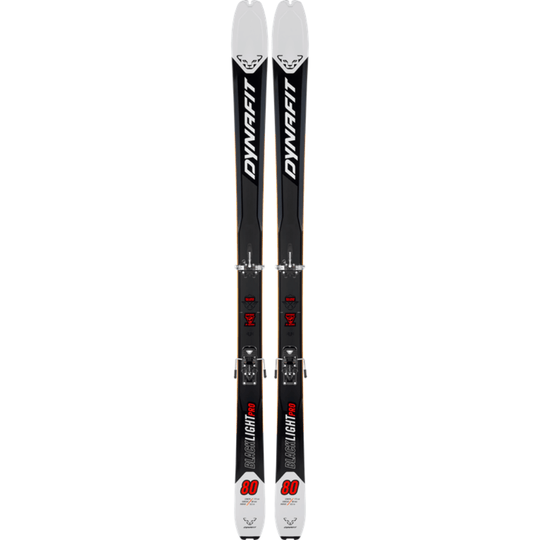
Atomic Backland 85 UL
The Atomic Backland 85 UL Ski is the ultimate choice for high-output ski tourers seeking a blend of lightweight efficiency, responsiveness, and versatility. At its core, the Backland 85 UL features an ultra-light wood core construction reinforced with fiberglass and a carbon backbone. This construction maintains a low weight (1274 g 172 cm) while delivering impressive snappiness and edge grip. We think of the Backland 85 UL as one of the most versatile skis in its class, and the rocker and extra width lend it to handling a wider range of snow than many mountaineering and fitness skis.
What we like
The 85 UL is our go-to for someone looking for a ski mountaineering tool who might venture into deeper snow or find themselves churning out resort fitness laps. Specifically, we appreciate that Atomic made this ski more forgiving than some competitors. The horizon tip gives additional flotation, and the progressive flex at the tip and tail makes the 85 UL easier to ski, which is a massive bonus in consequential terrain. Another important bonus of the Backland 85 is that, while it’s still an ultralight ski, Atomic gave it a little more heft than its competitors, and this is certainly a bonus on the descent as it allows the ski to punch through crud and reduces deflection (although it certainly doesn't eliminate the deflection issue).
What we don’t like
Atomic makes a fixed-length skin with great tip and tail attachments for this ski, but they use a hybrid glue (hybrid glue is easier to pull apart and can be cleaned but is generally less sticky). These skins are suitable for resort laps or smaller days, but the true spirit of this ski is big mountains and alpine lines. We wish they used stickier glue for these conditions since kicking a skin on an exposed and steep skin track is inconvenient and potentially dangerous. The 85 UL utilizes a semi-cap construction (ABS sidewall underfoot, capped construction at the tip and tails). Without getting too into the weeds, capped constructions are lighter but less durable and have less torsional rigidity and edge grip. Many lightweight skis have a semi-cap construction, but the backland has really minimized the ABS sidewall. We prefer the sidewall stretched further toward the tip to provide a little bit more edge reinforcement.
Bottom line: The Backland 85 UL is the perfect ski for someone looking for a mountaineering and fitness ski who may also find themselves skiing in softer snow and/or taking their light gear into more variable conditions.
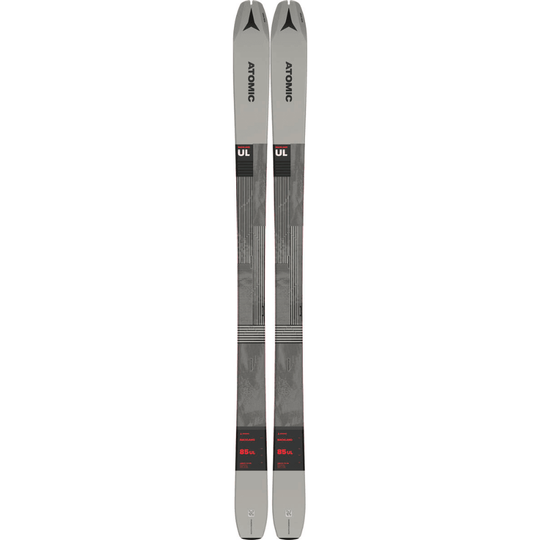
Honorable Mention: Black Crows Mentis Freebird
The Mentis makes the list because it is the most fun I’ve personally ever had on a lightweight, narrow ski. I took it for a ride with the Black Crows crew at Aspen Highlands and was amazed by the performance. It’s extremely stiff and returns an incredible amount of energy. Skiing packed powder bumps, it wanted to pop off every lip, and it’s low swing weight made it extremely nimble. Yet, at speed in variable snow, I was amazed by how stable, sturdy, and planted I felt. It felt like a freeride ski packed into an 80 mm waist toothpick. The only reason I call it an honorable mention is that its character appeals to a narrow range of skiers' styles. However, consider the Mentis if you want a lightweight mountaineering ski with a freeride heritage.
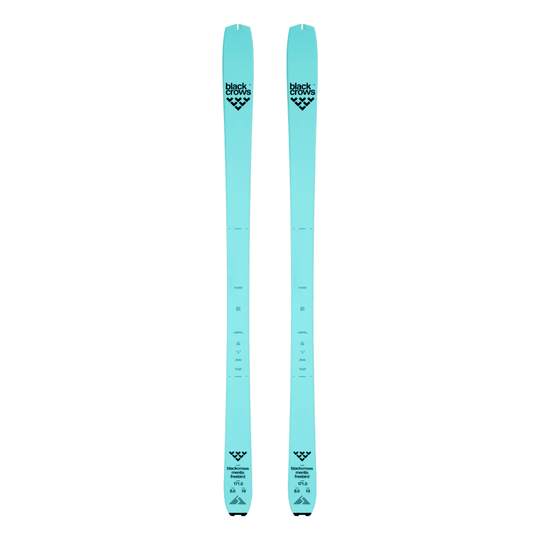
Freeride
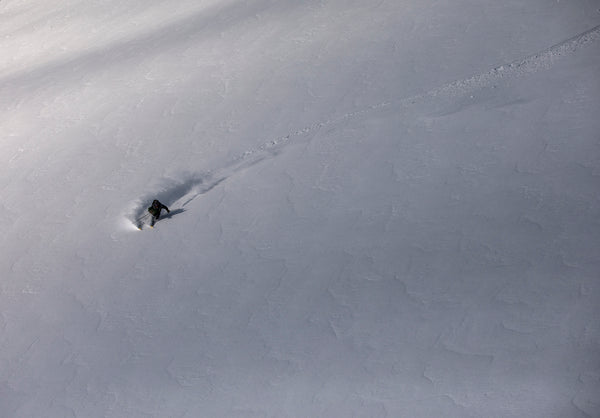
A quick caveat for freeride skis. In our mind, freeride touring skis sit in two categories: powder freeride and true freeride. This may seem esoteric, but it’s worth making a distinction. True freeride skis are meant to handle variable snow, big landings, and high speeds. The demanding nature of this type of skiing requires that a ski be built with a heavier construction that's more damp and stable at speed. Few touring skis are “true” freeride skis because as you lighten the ski construction, you lose the high-speed, variable snow performance needed in freeride-style skiing. On the other hand, powder freeride skis are meant for skiing deep, consistent powder. In this case, a burly and heavy construction is secondary to building a wider, floaty ski.
Salmon QST Echo 106
If you are familiar with the normal QST 106, you'll know it is a ski adored by a wide range of skiers and styles. From hard-charging free-riders to folks looking to have fun making mellow powder turns, Salomon has created a ski with mass appeal. This is good news for the Echo, as it keeps the same shape and design as the beloved QST 106. The difference arises in the ski core layup, which features a karuba/poplar core with basalt fibers and cork to dampen and stabilize the ski. Salomon claims this core layup shaves 300 g from the skis compared to standard 106, which still results in a heavy touring ski. At 1740 grams (173 cm), the Echo isn’t going to be setting any speed records uphill.
What we like
I first got my hands on the Echo during a resort chopped powder day, which, in my mind, is the perfect place to really put a ski to the test. The Echo performed admirably and could eat up chopped moguls and stay stable. Compared to the standard 106, I noticed slightly more chatter on the edge, and of course, the reduced weight contributed to tip deflection. Still, it was extremely manageable, and I didn't feel limited by the ski, even when skiing extremely aggressively. The Echo has really managed to maintain the characteristics of the QST 106, and this is great news as it means it’s playful, easy to drive, and highly consistent.
What we don’t like
The QST Echo is still a heavy ski, and it suffers from being caught in no man's land. It’s a lot of ski to haul out into the backcountry for bigger days, and if you plan on skiing primarily in the resort or really put a premium on downhill performance, you may want to take the weight penalty and go for a true freeride resort ski. Another small gripe, but the Echo still has a mildly rounded tail and no skin clip cutout, meaning your skins might be popping off easier than many other options.
Bottom line: For people wanting a ski that can rip the resort and the backcountry all while feeling like a familiar and beloved ski, the Echo 106 is worth serious consideration.
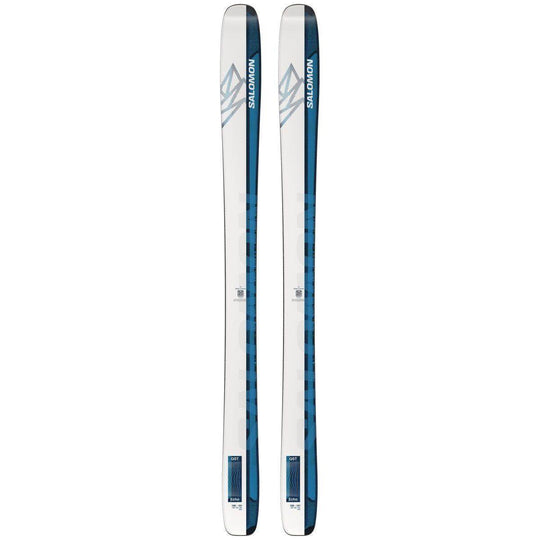
DPS Kaizen 105
The DPS Kaizen is a ground-up redesign of DPS's ski construction, and with it, they hope to create a ski that can take you up lifts and into the backcountry. The Kaizen 105 is specifically designed for people looking for speed and who like to carve. The directional shape provides a longer, effective edge and better edge grip, while the rocker through the tip still keeps the ski nimble and floaty. The core construction of the Kaizen features a double carbon laminate encompassing an ash and poplar wood core. Dampness is the name of the game with the Kaizen, and everything from the glue used in the layup to the "split core” nature of the wood core aim to suck up vibration.
What we like
I've skied extensively on DPS's freeride and touring skis, and the Kaizen felt like a wonderful mix of lightweight snappiness and low swing weight while still maintaining the characteristics of my much heavier and bigger Foundation 106s. In bumps and chop, the ski was easy to pivot and maneuver. I especially appreciated how the ski would open up and gain speed and then easily be shut down. People always claim that DPS skis make them feel like better skiers, which certainly felt true for the Kaizen 105. The Kiazen also comes with DPS’s new lifetime warranty, so rest assured that DPS has your back.
What we don't like:
It's hard to discuss DPS without talking about price points, and at $1,549, the Kaizen is no different. DPS will tell you that you are buying a true one ski quiver, and thus, having a ski that can do it all, from resort days to the backcountry, will save you money. I'm always dubious of one ski quiver claims, but if anyone can pull it off, it's DPS. If you are looking for a dedicated touring ski, the Kiazen is a bit heavy (1800 g 179 cm), so for a dedicated touring ski, consider DPS's Pagoda Tour line.
Bottom line: The Kaizen is close to a one-ski quiver, and if you want a ski that can truly ski anything, the Kaizen will be hard to top.
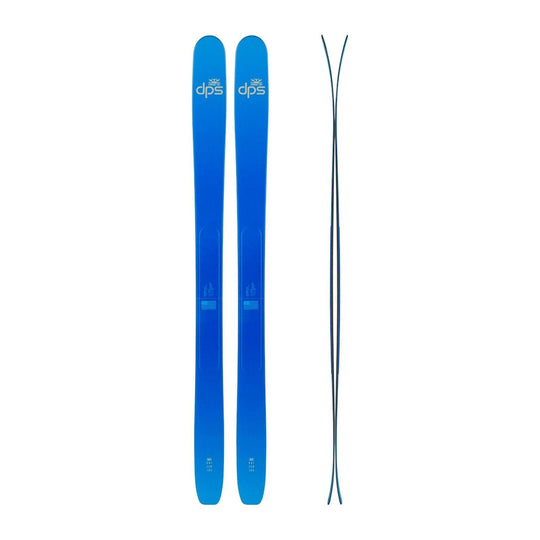
Skimo Race
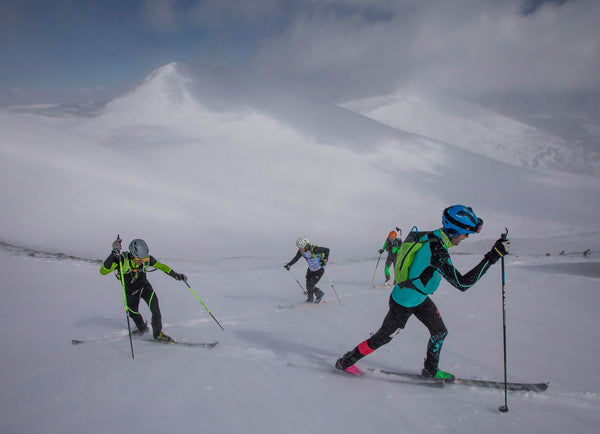
Dyanfit DNA/ DNA Pro
As a brand, Dynafit is synonymous with skimo racing. Their latest iterations of race skis are built on a long legacy of designing race-winning tools, and their industry experience is clearly apparent. The DNA skis use the Dynafit Race construction with premium Paulownia and unidirectional carbon stringers. Dynafit claims a 690 g weight, although we've found these skis to weigh closer to 710 g in our tests. Regardless of the discrepancy, the DNA is extremely light and a podium-capable ski. The DNA Pro ski has a loner turning radius and less tip rocker, making it more suited to high-speed descents than the standard DNA. The standard DNA is better suited to variable snow and racers who want a more forgiving ski.
What we like
Because Dynafit created two skis with one suited for more advanced racers, the DNA can accommodate a wider range of skier needs. More options mean that you can tailor the ski to your style and needs, and this choice makes it much more likely you will have a good experience on your chosen ski. The DNA skis are also some of the more durable skimo race skis on the market, thanks to their nearly full-length sidewall. While all race skis sacrifice some level of durability for weight saving, the DNA skis hold up extremely well and are further backed by Dyanfit's killer warranty.
What we don't like
The biggest complaint we hear about the DNA skis is that they don't ski quite as well as their competitors. The stiff carbon nature of the skis makes them more chattery than other skis. Ultimately, you'll still get down, and you can get down fast if you modify your skiing style (something necessary on all race skis), but for folks just starting out, the DNA will require a bigger adjustment period than other options.
Bottom line: The DNA and the DNA Pro are a top choice for someone looking for a premium race ski that is dependable and quick on the up and down.

Atomic Backland 65 UL
The Backland 65 UL has become a fan favorite due to its weight (690g 161 cm) and downhill performance. The Backland uses a Karuba+Poplar core with a carbon laminate. This differs from the Paulownia cores often found in light skis, and we think that Atomic is onto something with this design. The ski feels easy to control and responsive while lighter than other race skis on the market.
What we like
The real selling point of the Backland 65 UL is how much downhill performance it packs into its 690 grams. The Backland is an excellent choice for people worried about getting on a race ski and struggling on the descent. The Backland is also one of the more budget-friendly options on the market, and we appreciate that this makes skimo more accessible to the masses.
What we don't like
Our biggest qualm with the Atomic Backland is durability. The ski uses a full cap construction, and although they've taken measures to create a strong edge, the lack of sidewall reduces the ski's strength.
Bottom line: If you want a budget friendly race ski that easier to descend on that most race skis, the 65 UL is your goto.





